Samsung Electronics Co SMV101F Cellular/PCS GSM/WCDMA Portable Hotspot with WLAN User Manual V101F UM EU Eng indb
Samsung Electronics Co Ltd Cellular/PCS GSM/WCDMA Portable Hotspot with WLAN V101F UM EU Eng indb
Users Manual

Type E. A00000
02/2014. Rev.1.0
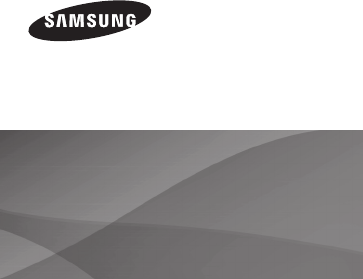
Samsung Mobile Hotspot
User manual
www.samsung.com

2
Copyright © 2014 Samsung Electronics
• Please read this manual before
using the device to ensure safe and
proper use.
• Images may differ in appearance
from the actual product. Content
is subject to change without prior
notice.
• This product includes certain free/
open source software. The exact
terms of the licences, disclaimers,
acknowledgements and notices are
available on the Samsung's website
opensource.samsung.com
.
3
Trademarks
• SAMSUNG and the SAMSUNG logo
are registered trademarks of Samsung
Electronics.
• Wi-Fi
®
, Wi-Fi Protected Setup
™
, Wi-Fi
CERTIFIED
™
, and the Wi-Fi logo are
registered trademarks of the Wi-Fi Alliance.
Your device uses a non-harmonised
frequency and is intended for use in all
European countries. The WLAN can be
operated in the EU without restriction
indoors, but cannot be operated outdoors.
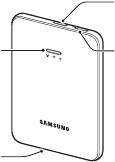
4
Getting Started
Device layout
Notification
light
Multipurpose
jack
Power
button
WPS button

5
Getting Started
5
Package contents
Check the product box for the following
items:
• Device
• Battery
The items supplied with the device
and any available accessories may
vary depending on the region or
service provider.
Installing the SIM or USIM card
and battery
Insert the SIM or USIM card provided by the
mobile telephone service provider, and the
included battery.
Only microSIM cards work with the
device.
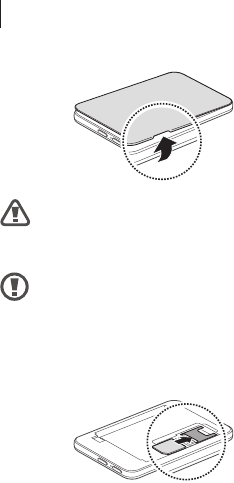
6
Getting Started
6
1
Remove the back cover.
Be careful not to damage your
fingernails when you remove the
back cover.
Do not bend or twist the back cover
excessively. Doing so may damage
the cover.
2
Insert the SIM or USIM card with the gold-
coloured contacts facing downwards.

7
Getting Started
7
3
Insert the battery.
1
2
4
Replace the back cover.
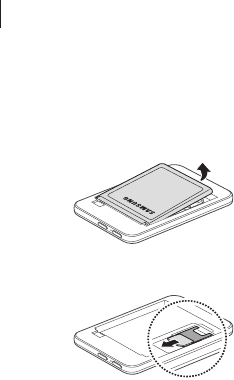
8
Getting Started
8
Removing the SIM or USIM card and
battery
1
Remove the back cover.
2
Pull out the battery.
3
Pull out the SIM or USIM card.

9
Getting Started
9
Charging the battery
Before using the device for the first time
or when the battery has been unused for
extended periods, you must charge the
battery.
Use only Samsung-approved
chargers, batteries, and cables.
Unapproved chargers or cables can
cause the battery to explode or
damage the device.
Connect the USB cable to the USB power
adaptor and then plug the end of the USB
cable into the multipurpose jack.

10
Getting Started
10
Connecting the charger improperly
may cause serious damage to
the device. Any damage caused
by misuse is not covered by the
warranty.
After fully charging, disconnect the device
from the charger. First unplug the charger
from the device, and then unplug it from the
electric socket.
Do not remove the battery before
removing the charger. This may
damage the device.

11
Getting Started
11
• To save energy, unplug the charger
when not in use. The charger does
not have a power switch, so you
must unplug the charger from the
electric socket when not in use to
avoid wasting power. The charger
should remain close to the electric
socket and easily accessible while
charging.
• The socket-outlet shall be installed
near the equipment and shall be
easily accessible.
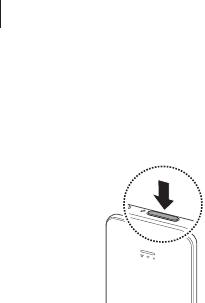
12
Getting Started
12
Turning the device on and off
Press and hold the Power button for a few
seconds to turn on the device. While the
device is turned on, all notification lights
turn green.
To turn off the device, press and hold the
Power button again.
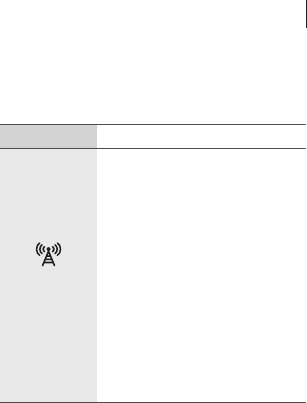
13
Getting Started
13
Notification light
The notification light alerts you to the
device’s status with the following colours.
Name Status
LTE/3G/2G
network
• Steady green: LTE network
connected
• Blinking green: LTE
network roaming
• Steady blue: 3G or 2G
network connected
• Blinking blue: 3G or 2G
network roaming
• Steady red: Weak signal
• Blinking red: Weak
roaming signal

14
Getting Started
14
Name Status
Wi-Fi
network
• Steady green: Devices
connected
• Blinking green: Data
transferring
• Steady blue: Ready to
connect to devices
• Blinking blue: WPS
standby mode
• Blinking red: Notification
alert or error occurred
Battery
power
• Steady green: 50 % –
100 %
• Blinking green: Fully
charged
• Steady blue: 15 % – 49 %
• Steady red: Charging
• Blinking red: Less than
15 % or error occurred

15
Getting Started
15
Connecting with other devices
Connect your device with computers
or other devices that support the
Wi-Fi function. When your device is
connected, recently-connected devices
will automatically connect to your device
whenever it is turned on.
The default password is the last 8 digits of
the IMEI number. The IMEI number is on a
label affixed to the device.
IMEI label
You must insert a SIM or USIM card to
use the device.

16
Getting Started
16
Connecting to a network via Wi-Fi
1
Turn on your device.
2
On other devices, access Wi-Fi settings
and search for the network.
3
Select the device name from the search
results.
4
Enter a password if necessary.
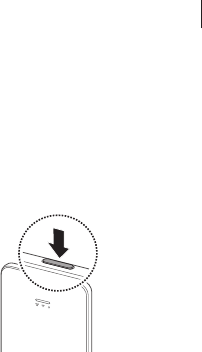
17
Getting Started
17
Activating Wi-Fi Protected Setup
(WPS) mode
You can connect devices to a network and
encrypt data by pushing the WPS button.
1
Press and hold the WPS button. The
notification light flashes green when the
WPS mode is activated.
2
Activate the WPS mode on other devices.
The devices enter WPS setup mode.
3
Press the WPS button again within
2 minutes.

18
Getting Started
18
Connecting to a network using a USB
cable
1
Turn on your device.
2
Connect the device to the computer
using the USB cable.
3
Select the device name from the network
list.
4
Enter a password if necessary.
Upgrading the device
The device can be upgraded to the latest
software.
On the computer, launch Samsung Kies and
connect the device to the computer. Refer
to the Samsung Kies help for details on how
to upgrade.

19
Getting Started
19
Configuring the device
When the device is connected to other
devices, access the administration page to
configure the device.
On the connected device, open the web
browser and go to
http://192.168.1.1
.
When the password request appears, enter
the password. The default password is
‘admin.’
At the top of the administration page, five
tabs will be shown. Select tabs to access the
following options:
Home
View information about the device and the
network.

20
Getting Started
20
Messages
•
Inbox
: View messages saved on the device
or the SIM card. Or, send and receive
messages.
•
SMS over mode
: Select a network to send
messages.
Network
•
Network info
: View the current network
information.
•
DHCP server
: Set the device to operate
as a Dynamic Host Configuration Protocol
(DHCP) server.
•
Wi-Fi settings
: Configure Wi-Fi settings
such as network name and password.

21
Getting Started
21
Security
Lock your SIM card and restrict access to
authorised devices only.
Settings
•
Mobile network
: Select the default
network to use.
•
Options
: Change the settings for the
administration page.
Resetting the device
On the connected device, access the
administration page. Open the web browser
and go to
http://192.168.1.1
.
When the password request appears, enter
the password. The default password is
‘admin.’
At the top of the administration page, tap
Network
→
Wi-Fi settings
→
Reset
.
22
Safety information
This safety information contains content for the
device. Some content may be not applicable to your
device. To prevent injury to yourself and others or
damage to your device, read the safety information
about your device before using the device.
Do not use your device outdoor during a
thunderstorm
Do not drop or cause an impact to the device
Handle and dispose of the device with care
• Never dispose of the battery or device in a fire. Never
place the battery or device on or in heating devices,
such as microwave ovens, stoves, or radiators. The
device may explode when overheated. Follow all local
regulations when disposing of used battery or device.
• Never crush or puncture the device.
• Avoid exposing the device to high external pressure,
which can lead to an internal short circuit and
overheating.

23
Safety information
23
Do not use or store your device in areas with high
concentrations of dust or airborne materials
Dust or foreign materials can cause your device to
malfunction and may result in fire or electric shock.
Do not bite or suck the device or the battery
Keep your device dry
Do not store your device in very hot or very cold
areas. It is recommended to use your device at
temperatures from 5 °C to 35 °C
Do not store your device near magnetic fields
Do not use your device with the back cover removed
When cleaning your device, mind the following
• Wipe your device with a towel or an eraser.
• Clean the battery terminals with a cotton ball or a
towel.
• Do not use chemicals or detergents. Doing so may
discolour or corrode the outside the device or may
result in electric shock or fire.

24
Safety information
24
Correct disposal of this product
(Waste Electrical & Electronic Equipment)
(Applicable in countries with separate
collection systems)
This marking on the product, accessories or
literature indicates that the product and its
electronic accessories (e.g. charger, headset, USB cable)
should not be disposed of with other household waste.
To prevent possible harm to the environment or
human health from uncontrolled waste disposal, please
separate these items from other types of waste and
recycle them responsibly to promote the sustainable
reuse of material resources.
Household users should contact either the retailer
where they purchased this product, or their local
government office, for details of where and how they
can take these items for environmentally safe recycling.
Business users should contact their supplier and check
the terms and conditions of the purchase contract. This
product and its electronic accessories should not be
mixed with other commercial wastes for disposal.
This EEE is compliant with RoHS.

25
Safety information
25
Correct disposal of batteries in this
product
(Applicable in countries with separate
collection systems)
This marking on the battery, manual or
packaging indicates that the batteries in
this product should not be disposed of with other
household waste. Where marked, the chemical symbols
Hg, Cd or Pb indicate that the battery contains mercury,
cadmium or lead above the reference levels in EC
Directive 2006/66. If batteries are not properly disposed
of, these substances can cause harm to human health
or the environment.
To protect natural resources and to promote material
reuse, please separate batteries from other types of
waste and recycle them through your local, free battery
return system.

Declaration of Conformity
Product details
For the following
Product : GSM WCDMA LTE BT/WiFi Mobile Phone
Model(s) :
Declaration & Applicable standards
We hereby declare, that the product above is in compliance with the essential requirements of the R&TTE
Directive (1999/5/EC) by application of:
SAFETY
SAR
EMC
RADIO
and the Directive (2011/65/EU) on the restriction of the use of certain hazardous substances in electrical and
electronic equipment by application of EN 50581:2012.
The conformity assessment procedure referred to in Article 10 and detailed in Annex[IV] of Directive 1999/5/
EC has been followed with the involvement of the following Notified Body(ies):
TÜV SÜD BABT, Octagon House, Concorde Way, Fareham,
Hampshire, PO15 5RL, UK*
Identification mark: 0168
Representative in the EU
Samsung Electronics Euro QA Lab.
Blackbushe Business Park, Saxony Way,
Yateley, Hampshire, GU46 6GG, UK
2014.02.10 Stephen Colclough / EU Representative
(Place and date of issue) (Name and signature of authorised person)
* This is not the address of Samsung Service Centre. For the address or the phone number of Samsung
Service Centre, see the warranty card or contact the retailer where you purchased your product.

Health and safety information
Exposure to Radio Frequency (RF) Signals
Certification Information (SAR)
Your wireless device is a radio transmitter and receiver. It is designed and
manufactured not to exceed the exposure limits for radio frequency (RF) energy set
by the Federal Communications Commission (FCC) of the U.S. government. These
FCC exposure limits are derived from the recommendations of two expert
organizations, the National Counsel on Radiation Protection and Measurement
(NCRP) and the Institute of Electrical and Electronics Engineers (IEEE). In both
cases, the recommendations were developed by scientific and engineering experts
drawn from industry, government, and academia after extensive reviews of the
scientific literature related to the biological effects of RF energy.
The exposure limit set by the FCC for wireless mobile devices employs a unit of
measurement known as the Specific Absorption Rate (SAR). The SAR is a measure
of the rate of absorption of RF energy by the human body expressed in units of watts
per kilogram (W/kg). The FCC requires wireless devices to comply with a safety limit
of 1.6 watts per kilogram (1.6 W/ kg). The FCC exposure limit incorporates a
substantial margin of safety to give additional protection to the public and to account
for any variations in measurements.
SAR tests are conducted using standard operating positions accepted by the FCC
with the device transmitting at its highest certified power level in all tested frequency
bands. Although the SAR is determined at the highest certified power level, the
actual SAR level of the device while operating can be well below the maximum value.
This is because the device is designed to operate at multiple power levels so as to
use only the power required to reach the network. In general, the closer you are to a
wireless base station antenna, the lower the power output.
Before a new model device is available for sale to the public, it must be tested and
certified to the FCC that it does not exceed the exposure limit established by the
FCC. Tests for each model device are performed in positions and locations (e.g. at
the ear and worn on the body) as required by the FCC.
Non-compliance with the above restrictions may result in violation of FCC RF
exposure guidelines.
SAR information on this and other model devices can be viewed on-line at
http://www.fcc.gov/oet/ea/fccid/. Please use the device FCC ID number for search,
A3LSMV101F. Sometimes it may be necessary to remove the battery pack to find
the number. Once you have the FCC ID number for a particular device, follow the
instructions on the website and it should provide values for typical or maximum SAR
for a particular device. Additional product specific SAR information can also be
obtained at http://www.fcc.gov/encyclopedia/specific-absorption-rate-sar-cellular-teledevices
Consumer Information on Wireless Devices
The U.S. Food and Drug Administration (FDA) has published a series of Questions
and Answers for consumers relating to radio frequency (RF) exposure from wireless
devices. The FDA publication includes the following information:
What kinds of devices are the subject of this update?
The term wireless device refers here to hand-held wireless devices with built-in
antennas, often called “cell,” “mobile,” or “PCS” devices. These types of wireless
devices can expose the user to measurable radio frequency energy (RF) because of
the short distance between the device and the user's head. These RF exposures are
limited by Federal Communications Commission safety guidelines that were
developed with the advice of FDA and other federal health and safety agencies.
When the device is located at greater distances from the user, the exposure to RF is
drastically lower because a person's RF exposure decreases rapidly with increasing
distance from the source. The so-called “cordless devices,” which have a base unit
connected to the teledevice wiring in a house, typically operate at far lower power
levels, and thus produce RF exposures well within the FCC's compliance limits.
Do wireless devices pose a health hazard?
The available scientific evidence does not show that any health problems are
associated with using wireless devices. There is no proof, however, that wireless
devices are absolutely safe. Wireless devices emit low levels of radio frequency
energy (RF) in the microwave range while being used. They also emit very low levels
of RF when in the stand-by mode. Whereas high levels of RF can produce health
effects (by heating tissue), exposure to low level RF that does not produce heating
effects causes no known adverse health effects. Many studies of low level RF
exposures have not found any biological effects. Some studies have suggested that
some biological effects may occur, but such findings have not been confirmed by
additional research. In some cases, other researchers have had difficulty in
reproducing those studies, or in determining the reasons for inconsistent results.
What is FDA's role concerning the safety of wireless devices?
Under the law, FDA does not review the safety of radiation-emitting consumer
products such as wireless devices before they can be sold, as it does with new drugs
or medical devices. However, the agency has authority to take action if wireless
devices are shown to emit radio frequency energy (RF) at a level that is hazardous
to the user. In such a case, FDA could require the manufacturers of wireless devices
to notify users of the health hazard and to repair, replace or recall the devices so that
the hazard no longer exists.
Although the existing scientific data do not justify FDA regulatory actions, FDA has
urged the wireless device industry to take a number of steps, including the following:
“Support needed research into possible biological effects of RF of the type
emitted by wireless devices;
“Design wireless devices in a way that minimizes any RF exposure to the
user that is not necessary for device function; and
“Cooperate in providing users of wireless devices with the best possible
information on possible effects of wireless device use on human health.
FDA belongs to an interagency working group of the federal agencies that have
responsibility for different aspects of RF safety to ensure coordinated efforts at the
federal level. The following agencies belong to this working group:
“National Institute for Occupational Safety and Health
“Environmental Protection Agency
“Federal Communications Commission
“Occupational Safety and Health Administration
“National Telecommunications and Information Administration
The National Institutes of Health participates in some interagency working group
activities, as well.
FDA shares regulatory responsibilities for wireless devices with the Federal
Communications Commission (FCC). All devices that are sold in the United States
must comply with FCC safety guidelines that limit RF exposure. FCC relies on FDA
and other health agencies for safety questions about wireless devices.
FCC also regulates the base stations that the wireless device networks rely upon.
While these base stations operate at higher power than do the wireless devices
themselves, the RF exposures that people get from these base stations are typically
thousands of times lower than those they can get from wireless devices. Base
stations are thus not the primary subject of the safety questions discussed in this
document.
What are the results of the research done already?
The research done thus far has produced conflicting results, and many studies have
suffered from flaws in their research methods. Animal experiments investigating the
effects of radio frequency energy (RF) exposures characteristic of wireless devices
have yielded conflicting results that often cannot be repeated in other laboratories. A
few animal studies, however, have suggested that low levels of RF could accelerate
the development of cancer in laboratory animals. However, many of the studies that
showed increased tumor development used animals that had been genetically
engineered or treated with cancer-causing chemicals so as to be pre-disposed to
develop cancer in absence of RF exposure. Other studies exposed the animals to
RF for up to 22 hours per day. These conditions are not similar to the conditions
under which people use wireless devices, so we don't know with certainty what the
results of such studies mean for human health.
Three large epidemiology studies have been published since December 2000.
Between them, the studies investigated any possible association between the use of
wireless devices and primary brain cancer, glioma, meningioma, or acoustic
neuroma, tumors of the brain or salivary gland, leukemia, or other cancers. None of
the studies demonstrated the existence of any harmful health effects from wireless
devices RF exposures. However, none of the studies can answer questions about
long-term exposures, since the average period of device use in these studies was
around three years.
What research is needed to decide whether RF exposure from wireless devices
poses a health risk?
A combination of laboratory studies and epidemiological studies of people actually
using wireless devices would provide some of the data that are needed. Lifetime
animal exposure studies could be completed in a few years. However, very large
numbers of animals would be needed to provide reliable proof of a cancer promoting
effect if one exists. Epidemiological studies can provide data that is directly
applicable to human populations, but ten or more years' follow-up may be needed to
provide answers about some health effects, such as cancer. This is because the
interval between the time of exposure to a cancer-causing agent and the time tumors
develop - if they do - may be many, many years. The interpretation of
epidemiological studies is hampered by difficulties in measuring actual RF exposure
during day-to-day use of wireless devices. Many factors affect this measurement,
such as the angle at which the device is held, or which model of device is used.
What is FDA doing to find out more about the possible health effects of
wireless device RF?
FDA is working with the U.S. National Toxicology Program and with groups of
investigators around the world to ensure that high priority animal studies are
conducted to address important questions about the effects of exposure to radio
frequency energy (RF).
FDA has been a leading participant in the World Health Organization international
Electromagnetic Fields (EMF) Project since its inception in 1996. An influential result
of this work has been the development of a detailed agenda of research needs that
has driven the establishment of new research programs around the world. The
Project has also helped develop a series of public information documents on EMF
issues.
FDA and Cellular Telecommunications & Internet Association (CTIA) have a formal
Cooperative Research and Development Agreement (CRADA) to do research on
wireless device safety. FDA provides the scientific oversight, obtaining input from
experts in government, industry, and academic organizations. CTIA-funded research
is conducted through contracts to independent investigators. The initial research will
include both laboratory studies and studies of wireless device users. The CRADA will
also include a broad assessment of additional research needs in the context of the
latest research developments around the world.
What steps can I take to reduce my exposure to radio frequency energy from
my wireless device?
If there is a risk from these products - and at this point we do not know that there is -
it is probably very small. But if you are concerned about avoiding even potential risks,
you can take a few simple steps to minimize your exposure to radio frequency
energy (RF). Since time is a key factor in how much exposure a person receives,
reducing the amount of time spent using a wireless device will reduce RF exposure.
“If you must conduct extended conversations by wireless device every day,
you could place more distance between your body and the source of the RF,
since the exposure level drops off dramatically with distance. For example,
you could use a headset and carry the wireless device away from your body.
Again, the scientific data do not demonstrate that wireless devices are harmful. But if
you are concerned about the RF exposure from these products, you can use
measures like those described above to reduce your RF exposure from wireless
device use.
What about children using wireless devices?
The scientific evidence does not show a danger to users of wireless devices,
including children and teenagers. If you want to take steps to lower exposure to radio
frequency energy (RF), the measures described above would apply to children and
teenagers using wireless devices. Reducing the time of wireless device use and
increasing the distance between the user and the RF source will reduce RF
exposure.
Some groups sponsored by other national governments have advised that children
be discouraged from using wireless devices at all. For example, the government in
the United Kingdom distributed leaflets containing such a recommendation in
December 2000. They noted that no evidence exists that using a wireless device
causes brain tumors or other ill effects. Their recommendation to limit wireless
device use by children was strictly precautionary; it was not based on scientific
evidence that any health hazard exists.
Do hands-free kits for wireless devices reduce risks from exposure to RF
emissions?
Since there are no known risks from exposure to RF emissions from wireless
devices, there is no reason to believe that hands-free kits reduce risks. Hands-free
kits can be used with wireless devices for convenience and comfort. These systems
reduce the absorption of RF energy in the head because the device, which is the
source of the RF emissions, will not be placed against the head. On the other hand,
if the device is mounted against the waist or other part of the body during use, then
that part of the body will absorb more RF energy. Wireless devices marketed in the
U.S. are required to meet safety requirements regardless of whether they are used
against the head or against the body. Either configuration should result in
compliance with the safety limit.
Do wireless device accessories that claim to shield the head from RF radiation
work?
Since there are no known risks from exposure to RF emissions from wireless
devices, there is no reason to believe that accessories that claim to shield the head
from those emissions reduce risks. Some products that claim to shield the user from
RF absorption use special device cases, while others involve nothing more than a
metallic accessory attached to the device. Studies have shown that these products
generally do not work as advertised. Unlike “hand-free” kits, these so-called “shields”
may interfere with proper operation of the device. The device may be forced to boost
its power to compensate, leading to an increase in RF absorption. In February 2002,
the Federal trade Commission (FTC) charged two companies that sold devices that
claimed to protect wireless device users from radiation with making false and
unsubstantiated claims. According to FTC, these defendants lacked a reasonable
basis to substantiate their claim.
What about wireless device interference with medical equipment?
Radio frequency energy (RF) from wireless devices can interact with some electronic
devices. For this reason, FDA helped develop a detailed test method to measure
electromagnetic interference (EMI) of implanted cardiac pacemakers and
defibrillators from wireless teledevices. This test method is now part of a standard
sponsored by the Association for the Advancement of Medical instrumentation
(AAMI). The final draft, a joint effort by FDA, medical device manufacturers, and
many other groups, was completed in late 2000. This standard will allow
manufacturers to ensure that cardiac pacemakers and defibrillators are safe from
wireless device EMI. FDA has tested wireless devices and helped develop a
voluntary standard sponsored by the Institute of Electrical and Electronic Engineers
(IEEE). This standard specifies test methods and performance requirements for
hearing aids and wireless devices so that no interference occurs when a person
uses a compatible device and a compatible hearing aid at the same time. This
standard was approved by the IEEE in 2000.
FDA continues to monitor the use of wireless devices for possible interactions with
other medical devices. Should harmful interference be found to occur, FDA will
conduct testing to assess the interference and work to resolve the problem.
Additional information on the safety of RF exposures from various sources can be

obtained from the following organizations:
FCC RF Safety Program:
http://www.fcc.gov/oet/rfsafety/
Environmental Protection Agency (EPA):
http://www.epa.gov/radiation/
Occupational Safety and Health Administration's (OSHA):
http://www.osha.gov/SLTC/radiofrequencyradiation/index.html
National institute for Occupational Safety and Health (NIOSH):
http://www.cdc.gov/niosh/
World health Organization (WHO):
http://www.who.int/peh-emf/
International Commission on Non-Ionizing Radiation Protection:
http://www.icnirp.de
National Radiation Protection Board (UK):
http://www.hpa-radiationservices.org.uk/rpa
Updated 4/3/2002: US food and Drug Administration
http://www.fda.gov/Radiation-
EmittingProducts/RadiationEmittingProductsandProcedures/HomeBusinessandEntertainment/
CellDevices/default.htm
Road Safety
Your wireless device gives you the powerful ability to communicate by voice, almost
anywhere, anytime. But an important responsibility accompanies the benefits of
wireless devices, one that every user must uphold.
When driving a car, driving is your first responsibility. When using your wireless
device behind the wheel of a car, practice good common sense and remember the
following tips:
1. Get to know your wireless device and its features, such as speed dial and
redial. If available, these features help you to place your call without taking
your attention off the road.
2. When available, use a hands-free device. If possible, add an additional layer
of convenience and safety to your wireless device with one of the many
hands free accessories available today.
3. Position your wireless device within easy reach. Be able to access your
wireless device without removing your eyes from the road. If you get an
incoming call at an inconvenient time, let your voice mail answer it for you.
4. Let the person you are speaking with know you are driving; if necessary,
suspend the call in heavy traffic or hazardous weather conditions. Rain, sleet,
snow, ice and even heavy traffic can be hazardous.
5. Do not take notes or look up device numbers while driving. Jotting down a “to
do” list or flipping through your address book takes attention away from your
primary responsibility, driving safely.
6. Dial sensibly and assess the traffic; if possible, place calls when you are not
moving or before pulling into traffic. Try to plan calls when your car will be
stationary. If you need to make a call while moving, dial only a few numbers,
check the road and your mirrors, then continue.
7. Do not engage in stressful or emotional conversations that may be distracting.
Make people you are talking with aware you are driving and suspend

conversations that have the potential to divert your attention from the road.
8. Use your wireless device to call for help. Dial 9-1-1 or other local emergency
number in the case of fire, traffic accident or medical emergencies.
Remember, it is a free call on your wireless device!
9. Use your wireless device to help others in emergencies. If you see an auto
accident, crime in progress or other serious emergency where lives are in
danger, call 9-1-1 or other local emergency number, as you would want
others to do for you.
10. Call roadside assistance or a special non-emergency wireless assistance
number when necessary. If you see a broken-down vehicle posing no serious
hazard, a broken traffic signal, a minor traffic accident where no one appears
injured, or a vehicle you know to be stolen, call roadside assistance or other
special non-emergency number.
“The wireless industry reminds you to use your device safely when driving.”
For more information, please call 1-888-901-SAFE, or visit our web-site
www.wow-com.com
Provided by the Cellular Telecommunications & Internet Association
Operating Environment
Remember to follow any special regulations in force in any area and always switch
your device off whenever it is forbidden to use it, or when it may cause interference
or danger. When connecting the device or any accessory to another device, read its
user's guide for detailed safety instructions. Do not connect incompatible products.
As with other mobile radio transmitting equipment, users are advised that for the
satisfactory operation of the equipment and for the safety of personnel, it is
recommended that the equipment should only be used in the normal operating
position.
Using Your Device Near Other Electronic Devices
Most modern electronic equipment is shielded from radio frequency (RF) signals.
However, certain electronic equipment may not be shielded against the RF signals
from your wireless device. Consult the manufacturer to discuss alternatives.
Pacemakers
Pacemaker manufacturers recommend that a minimum distance of 15 cm (6 inches)
be maintained between a wireless device and a pacemaker to avoid potential
interference with the pacemaker.
These recommendations are consistent with the independent research and
recommendations of Wireless Technology Research.
Persons with pacemakers:
should always keep the device more than 15 cm
(6 inches) from their pacemaker when the device is switched on.
should not carry the device in a breast pocket.
should use the ear opposite the pacemaker to minimize potential interference.
If you have any reason to suspect that interference is taking place, switch your
device off immediately.
Hearing Aids
Some digital wireless devices may interfere with some hearing aids. In the event of
such interference, you may wish to consult your hearing aid manufacturer to discuss

alternatives.
Other Medical Devices
If you use any other personal medical devices, consult the manufacturer of your
device to determine if it is adequately shielded from external RF energy. Your
physician may be able to assist you in obtaining this information. Switch your device
off in health care facilities when any regulations posted in these areas instruct you to
do so. Hospitals or health care facilities may be using equipment that could be
sensitive to external RF energy.
Vehicles
RF signals may affect improperly installed or inadequately shielded electronic
systems in motor vehicles. Check with the manufacturer or its representative
regarding your vehicle. You should also consult the manufacturer of any equipment
that has been added to your vehicle.
Posted Facilities
Switch your device off in any facility where posted notices require you to do so.
Potentially Explosive Environments
Switch your device off when in any area with a potentially explosive atmosphere and
obey all signs and instructions. Sparks in such areas could cause an explosion or fire
resulting in bodily injury or even death.
Users are advised to switch the device off while at a refueling point (service station).
Users are reminded of the need to observe restrictions on the use of radio
equipment in fuel depots (fuel storage and distribution areas), chemical plants or
where blasting operations are in progress.
Areas with a potentially explosive atmosphere are often but not always clearly
marked. They include below deck on boats, chemical transfer or storage facilities,
vehicles using liquefied petroleum gas (such as propane or butane), areas where the
air contains chemicals or particles, such as grain, dust or metal powders, and any
other area where you would normally be advised to turn off your vehicle engine.
Emergency Calls
This device, like any wireless device, operates using radio signals, wireless and
landline networks as well as user programmed functions, which cannot guarantee
connection in all conditions. Therefore, you should never rely solely on any wireless
device for essential communications (medical emergencies, for example).
Remember, to make or receive any calls the device must be switched on and in a
service area with adequate signal strength. Emergency calls may not be possible on
all wireless device networks or when certain network services and/ or device
features are in use. Check with local service providers.
To make an emergency call:
1. If the device is not on, switch it on.
2. Key in the emergency number for your present location (for example, 911 or
other official emergency number). Emergency numbers vary by location.
3. Press .
If certain features are in use (call barring, for example), you may first need to
deactivate those features before you can make an emergency call. Consult this
document and your local cellular service provider.
When making an emergency call, remember to give all the necessary information as
accurately as possible. Remember that your device may be the only means of
communication at the scene of an accident; do not cut off the call until given
permission to do so.
Restricting Children's access to your Device
Your device is not a toy. Children should not be allowed to play with it because they
could hurt themselves and others, damage the device or make calls that increase
your device bill.

FCC Notice and Cautions
FCC Notice
This device complies with Part 15 of the FCC Rules. Operation is subject to
the following two conditions: (1) this device may not cause harmful interference, and
(2) this device must accept any interference received, including interference that may
cause undesired operation.
This equipment has been tested and found to comply with the limits for a
Class B digital device, pursuant to part 15 of the FCC Rules. These limits are
designed to provide reasonable protection against harmful interference in a
residential installation. This equipment generates, uses and can radiate radio
frequency energy and, if not installed and used in accordance with the
instructions, may cause harmful interference to radio communications.
However, there is no guarantee that interference will not occur in a particular
installation. If this equipment does cause harmful interference to radio or
television reception, which can be determined by turning the equipment off
and on, the user is encouraged to try to correct the interference by one or
more of the following measures:
-Reorient or relocate the receiving antenna.
-Increase the separation between the equipment and receiver.
-Connect the equipment into an outlet on a circuit different from that to which the
receiver is connected.
-Consult the dealer or an experienced radio/TV technician for help.
The device may cause TV or radio interference if used in close proximity to receiving
equipment. The FCC can require you to stop using the device if such interference
cannot be eliminated.
Vehicles using liquefied petroleum gas (such as propane or butane) must comply
with the National Fire Protection Standard (NFPA-58). For a copy of this standard,
contact the National Fire Protection Association, One Battery march Park, Quincy,
MA 02269, Attn: Publication Sales Division.
Cautions
Changes or modifications made in the radio device, not expressly approved by
Samsung, will void the user’s authority to operate the equipment.
The use of any unauthorized accessories may be dangerous and void the device
warranty if said accessories cause damage or a defect to the device.
Although your device is quite sturdy, it is a complex piece of equipment and can be
broken. Avoid dropping, hitting, bending or sitting on it.